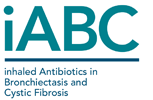Clinical Study Outputs
Four clinical studies have been carried out under the iABC project banner. Two have produced initial findings:
Inhaled Tobramycin (TIP) in Bronchiectasis patients (Phase II) – iBEST
Results are available.
The study aimed to determine the efficacy of a safe and well-tolerated dose and regimen of tobramycin inhalation powder (TIP) on Pseudomonas aeruginosa sputum density in patients with bronchiectasis.This is a phase II, double-blind, randomised study in bronchiectasis patients aged ≥18 years with chronic P. aeruginosa infection. Patients were randomised 1:1:1 to either cohort A: three capsules of TIP once daily (84 mg); cohort B: five capsules once daily (140 mg) or cohort C: four capsules twice daily (224 mg). Within each cohort, patients were further randomised 2:2:1 either to TIP continuously, TIP cyclically (alternating 28 days of TIP and placebo) or placebo for 16 weeks, respectively and were followed up for 8 weeks.Overall, 107 patients were randomised to cohorts A (n=34), B (n=36) and C (n=37). All three TIP doses significantly reduced the P. aeruginosa sputum density from baseline to day 29 versus placebo in a dose-dependent manner (p≤0.0001, each). A smaller proportion of patients in the continuous-TIP (34.1%) and cyclical-TIP (35.7%) groups experienced pulmonary exacerbations versus placebo (47.6%) and also required fewer anti-pseudomonal antibiotics (38.6% on continuous TIP and 42.9% on cyclical TIP) versus placebo (57.1%) although not statistically significant. Pulmonary exacerbation of bronchiectasis was the most frequent (37.4%) adverse event. Overall, TIP was well tolerated, however, 23.4% of the patients discontinued the study drug due to adverse events.Continuous- and cyclical-TIP regimens with all three doses were safe and effective in reducing the P. aeruginosa sputum density in patients with bronchiectasis and chronic P. aeruginosa infection.
Inhaled Murepavadin (iMPV) in Healthy Volunteers (Phase I)
Results available Q4 2023
The therapy, referred to as iMPV, contains the antibiotic murepavadin in a formulation designed to be inhaled through the mouth.This antibiotic can specifically kill P. aeruginosa, a bacteria that infects the majority of adults with CF, by targeting the bacteria’s outer membrane. According to Spexis, iMPV has shown efficacy against P. aeruginosa strains that are resistant to many other commonly used antibiotics. The Phase 1 trial was conducted to test the safety and pharmacological properties of iMPV in a total of 39 healthy volunteers. All participants received a single dose of the investigational therapy or a placebo. Neither the participants nor researchers knew who received iMPV and who got the placebo. A range of doses were tested — from as low as 12.5 mg to as high as 300 mg — in the single-center study.
Safety data from the trial suggest that iMPV was well-tolerated: all participants completed inhalation of the single dose, and there were no clinically relevant signs of airway irritation or changes in lung function. Vital signs and laboratory data also were in normal ranges, and no serious side effects related to treatment were documented. At the highest dose tested, 24 hours after the inhalation of iMPV, levels of the murepavadin antibiotic in participants’ lungs were above a concentration that would inhibit the growth of 90% of P. aeruginosa isolates in CF patients, according to Spexis. Levels in the blood peaked an hour or two after dosing, and remained below 5%. According to Spexis, the data suggests that iMPV could deliver a therapeutically effective dose of antibiotic to the lungs — the site of chronic infection in CF — without substantially increasing its blood levels elsewhere, in contrast to previous trials of murepavadin delivered intravenously, or into the vein.




